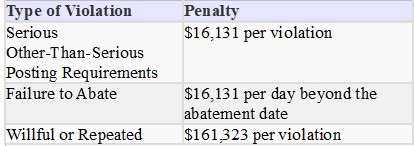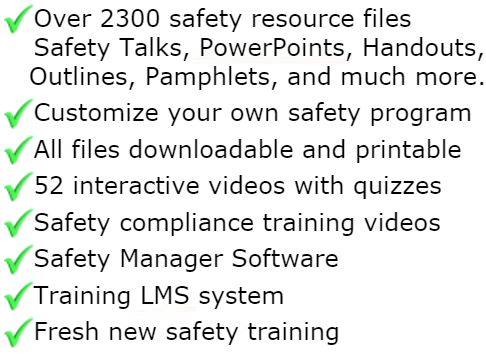
Safety Rules & Policies
Workplace safety rules and general safety policies are necessary parts of a comprehensive safety program. In addition to general safety rules, job specific safety rules are needed to ensure task safety training addresses all hazards for each job.
Hazard Reporting
Identification and reporting of potentially unsafe or unhealthful working conditions is the responsibility of all employees. Employees should be encouraged to report unsafe or unhealthful working conditions to their immediate supervisor to promptly investigate the situation and take appropriate corrective actions. .
Signs and Tags
Signs and tags are not intended as substitutes for preferred abatement methods such as engineering controls, substitution, isolation, or safe work practices. Rather, they are additional safety guidance and increase the employee's awareness of potentially hazardous situations.
Tags are temporary means of warning all concerned of a hazardous conditions, defective equipment, etc. Tags are not to be considered as a complete warning method, but should only be used until a positive means can be employed to eliminate the hazard; for example, a "Do Not Start" tag is affixed to a machine and is used only until the machine can be locked out, de-energized, or inactivated.
Planned Work
Work shall be planned and supervised to prevent injuries in the handling of materials and in working together with equipment. Employees shall not enter manholes, underground vaults, chambers, tanks, silos, or other similar places that receive little ventilation unless it has been determined that it is safe to enter. Confined spaces can be quite hazardous from toxic fumes, gas, and other hazards can gather in the spaces creating a dangerous hazard.
Machine guards and other protective devices must be in their proper place before machinery and equipment is used and employees must report any deficiencies or hazards to the supervisor when they are detected. If the equipment is unsafe to operate, do not operate the equipment until it has been replaced or repaired.
Hazard Safety Control
Substitution. The risk of injury or illness may be reduced by replacement of an existing process, material, or equipment with a similar item having more limited hazard potential Some examples include: brush painting instead of spray painting to reduce inhalation hazards, welding instead of riveting to reduce noise levels, use of safety cans instead of bottles to store flammable liquids, etc. Care must be exercised in any substitution to ensure that the substitute materials are technically acceptable and to avoid introducing a new or unforeseen hazards.
Isolation. Hazards are controlled by isolation whenever an appropriate barrier or limiter is placed between the hazard and an individual who may be affected by the hazard. This isolation can be in the form of physical barriers, time separation, or distance. Examples include machine guards, electrical insulation, glove boxes, acoustical containment, and remote controlled equipment.
Ventilation. The control of a potentially hazardous airborne substance by ventilation can be accomplished by one or two methods: diluting the concentration of the substance by mixing with uncontaminated air or capturing and removing the substance at its source or point of generation. Local exhaust ventilation is generally the preferred and more economical method of hazard control. However, dilution ventilation can be very effective for the removal of large volumes of heated air or for the removal of low concentrations of non-toxic or low toxicity contaminants from minor and decentralized sources.
Administrative Control. This method of hazard mitigation depends on effective operating practices that reduce the exposure of individuals to chemical or physical hazards. These practices may take the form of limited access to high hazard areas, preventive maintenance programs to reduce the potential for leakage of hazardous substances, or adjusted work schedules which involve a regimen of work in high hazard and low hazard areas. Adjusted work schedules are appropriate only when the hazard is recognized as having a limit below which nearly all workers may be repeatedly exposed without adverse effect.
Personal Protective Equipment. This method of hazard control is least preferred because personal protective devices may reduce a worker's productivity, while affording less effective protection against the recognized hazard than other methods of control. Nevertheless, there are instances where adequate levels of risk reduction cannot be achieved through other methods, and personal protective devices must be used, either alone or in conjunction with other protective measures.
All materials in the members area for this topic index

GET INSTANT ACCESS
to THE MEMBERS LIBRARY
Safety materials created by safety professionals.
Access to the Safety Manager software.
Wide variety of safety videos and courses.
**Brand New** Safety Training Management System
Pre-Made Safety Materials Ready For Use
Created by experienced safety professionals & risk consultants. Saving you time, money, and risk of injuries.
95% of the work already done.
Below are the maximum penalty amounts, with the annual adjustment for inflation, that may be assessed after Jan. 15, 2024. (See OSHA Memo, Jan. 8, 2024).

**New OSHA HEAT 90 DAY**
>>Download Free HERE<<
**New 2024 OSHA 300 Form**
>>Download Free HERE<<
**Brand New**
Free with full membership subscription
Training LMS System
Ask The Safety Consultant
Safety Equipment Deal Finder

“SafetyInfo.com is the first go-to website for safety professionals and companies to use in establishing a solid safety program"
-Mike McKenzie, Certified Safety & Health Manager (CSHM), McSafety Solutions™
Note: You must have a full subscription to the Safety Library in order to use this material. Any use outside of your organization, for resell, or without an active membership is strictly prohibited and may result in prosecution under copyright infringement laws. Please contact us first, if you would be interested in reselling or using our materials for reproduction.
Inside the Members Library
Topic Index
Accident Prevention
Air Quality
Asbestos
Bloodborne Pathogens
Boilers
Chemical Safety
Compressed Gas
Confined Space
Construction
Construction Worksite
Cranes & Slings
Driver / Fleet Safety
Drug Free Workplace
Electrical
Emergency Management
Engineering Safety
Environmental
Equipment
Ergonomics
Fall Protection
Fire Safety & Prevention
First Aid
Flammable Materials
Forklifts
Hazard Communication
Hazardous Materials
Hearing Protection
Heat Stress
Hot Work
Housekeeping
Job Safety Analysis
Laboratory
Ladders
Lead
Lockout-Tagout
Machinery & Equipment
Material Handling
MSDS (SDS)
Medical & First Aid
Occupational Health
Office Safety
Off the Job Safety
Personal Protection
Process Safety
Record Keeping
Respiratory Protection
Silica Safety
Rules & Policies
Signs & Labels
Slips, Trips & Fall
Training
Terrorism Programs
Tool Safety
Vehicle & Driver
Violence Programs
Welding & Hot Work
Training Videos
Library Index
Training Materials
Videos/Courses
Talks
Articles
PowerPoint
Handouts
Training Overheads
Quizzes
Supervisor Briefs
Management Briefs
Safety Sessions
2 Minute OSHA Safety Talks
Pamphlets
First Aid Training
Supervisor Training
Hazardous Materials
Bomb Threat
Crossword Puzzles
Biological Agents
Forms & Documents
Forms
Checklists
Audit Guides
Inspections Guides
Signs & Labels
Environmental Audit Guides
Recordkeeping - OSHA 300
Sign & Label Maker
Safety Management Resources
Safety Manuals/Written Programs
Ergonomic Programs
Emergency Plans
Process Safety Management
Construction Safety
Occupational Health
Environmental
Topic Sheets
DOT Fleet-Driver
Hazardous Materials
Chemical Safety
Drug Free Workplace
Terrorism Programs
Development Guides
Safety Manager Software
Safety References & Graphics
Technical Safety Information
Posters
Topic & Fact Sheets
Development Information
Job Specific Safety Rules
Terrorism
Calculators
Safety Comic Strips
New Safety Training System
Schedule and train your employees with our materials. Add unlimited amount of employees. Record all progress and issue certificates. For group and individual training sessions.

